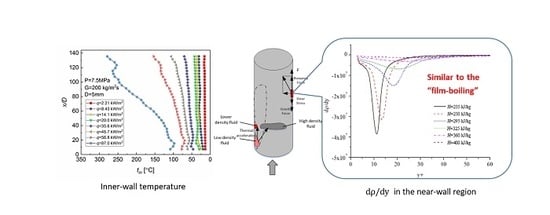Experimental and Numerical Investigation of Convective Heat Transfer of Supercritical Carbon Dioxide at Low Mass Fluxes
Abstract
:Featured Application
Abstract
1. Introduction
2. Experimental Setup and Data Reduction
3. Results and Discussion
3.1. Convective Heat Transfer of Supercritical CO2
3.2. Parametric Effect on Heat Transfer
3.2.1. Effect of Heat Flux
3.2.2. Effect of Mass Flux
3.2.3. Effect of Pressure
3.3. Buoyancy Effect on the Heat Transfer
4. Numerical Simulation of Mixed Convection
5. Conclusions
- (1).
- Special heat transfer behaviors at low mass flux are observed that are different from the cases at moderate and high mass fluxes. In this particular heat transfer process, the temperature monotonously increases without any remarkable peak with the increase in either bulk enthalpy or x/D.
- (2).
- Mixed convection in the heated channel is analyzed for different heat fluxes, and the parametric effects on the convective heat transfer are discussed. The buoyancy took effect only in a certain enthalpy range (for G = 100 kg/m2s, P = 7.5 MPa, and H < 300 kJ/kg). Furthermore, in the other high-enthalpy region, the “vapor-like” fluid occupies the near-wall region. The mass flux will promote the heat transfer, though pressure does just the opposite to heat transfer.
- (3).
- The mechanism of this particular heat transfer behavior at low mass fluxes is further investigated numerically. The lower specific heat capacity, lower thermal conductivity, lower viscosity, and lighter density continuously gather in the near-wall region, which is similar to the phenomenon that occurs in film boiling at subcritical pressure.
Acknowledgements
Author Contributions
Conflicts of Interest
Nomenclature
| Bo* | Buoyancy parameter, , dimensionless |
| cp | specific heat at constant pressure (J/kg·K) |
| d | inside diameter (m) |
| DNS | direct numerical simulation |
| G | mass flux (kg/m2s) |
| g | gravitational acceleration (m/s2) |
| Gr | Grashof number ( ), dimensionless |
| Gr* | Grashof number ( ), dimensionless |
| h | heat transfer coefficient (W/m2K) |
| H | specific enthalpy (kJ/kg) |
| L/ | length (m) |
| Pr | Prandtl number ( ), dimensionless |
| P | Pressure (MPa) |
| averaged heat flux (kW/m2) | |
| q | heat flux (kW/m2) |
| Re | Reynolds number ( ), dimensionless |
| r | radius (m) |
| t | temperature (°C) |
| T | temperature (K) |
| u | velocity vector (m/s) |
| x | location (m) |
| Greek symbols | |
| β | thermal expansion coefficient (1/°C) |
| μ | dynamic viscosity (Pa·s) |
| λ | thermal conductivity (W/(m·K)) |
| ν | viscosity (m2/s) |
| ρ | density (kg/m3) |
| τ | shear stress (Pa·s) |
| Subscripts | |
| b | at bulk temperature |
| c | at thermodynamic critical pressure |
| min | Minimum |
| pc | pseudocritical |
| w | at the wall temperature |
References
- Jackson, J.D. Fluid flow and convective heat transfer to fluids at supercritical pressure. Nucl. Eng. Des. 2013, 264, 24–40. [Google Scholar] [CrossRef]
- Duffey, R.; Pioro, I. Experimental heat transfer of supercritical carbon dioxide flowing inside channels (survey). Nucl. Eng. Des. 2005, 235, 913–924. [Google Scholar] [CrossRef]
- Cheng, L.; Ribatski, G.; Thome, J.R. Analysis of supercritical CO2 cooling in macro- and micro-channels. Int. J. Refrig. 2008, 31, 1301–1316. [Google Scholar] [CrossRef]
- Pioro, I.L.; Duffey, R.B. Heat Transfer & Hydraulic Resistance at Supercritical Pressures in Power Engineering Applications; ASME Press: New York, NY, USA, 2007. [Google Scholar]
- Bae, Y.-Y.; Kim, H.-Y.; Kang, D.-J. Forced and mixed convection heat transfer to supercritical CO2 vertically flowing in a uniformly-heated circular tube. Exp. Therm. Fluid Sci. 2010, 34, 1295–1308. [Google Scholar] [CrossRef]
- Bae, Y.Y.; Kim, H.Y. Convective heat transfer to CO2 at a supercritical pressure flowing vertically upward in tubes and an annular channel. Exp. Therm. Fluid Sci. 2009, 33, 329–339. [Google Scholar] [CrossRef]
- Xu, J.L.; Yang, C.Y.; Zhang, W.; Sun, D. Turbulent convective heat transfer of CO2 in a helical tube at near-critical pressure. Int. J. Heat Mass Transf. 2015, 80, 748–758. [Google Scholar] [CrossRef]
- Yang, C.Y.; Xu, J.L.; Wang, X.D.; Zhang, W. Mixed convective flow and heat transfer of supercritical CO2 in circular tubes at various inclination angles. Int. J. Heat Mass Transf. 2013, 64, 212–223. [Google Scholar] [CrossRef]
- Bae, J.H.; Yoo, J.Y.; Choi, H. Direct numerical simulation of turbulent supercritical flows with heat transfer. Phys. Fluids 2005, 17. [Google Scholar] [CrossRef]
- Bae, J.H.; Yoo, J.Y.; McEligot, D.M. Direct numerical simulation of heated CO2 flows at supercritical pressure in a vertical annulus at Re = 8900. Phys. Fluids 2008, 20. [Google Scholar] [CrossRef]
- Nemati, H.; Patel, A.; Boersma, B.J.; Pecnik, R. The effect of thermal boundary conditions on forced convection heat transfer to fluids at supercritical pressure. J. Fluid Mech. 2016, 800, 531–556. [Google Scholar] [CrossRef]
- Peeters, J.W.R.; Pecnik, R.; Rohde, M.; van der Hagen, T.H.J.J.; Boersma, B.J. Turbulence attenuation in simultaneously heated and cooled annular flows at supercritical pressure. J. Fluid Mech. 2016, 799, 505–540. [Google Scholar] [CrossRef]
- Chen, L.; Zhang, X.-R.; Jiang, B. Effects of Heater Orientations on the Natural Circulation and Heat Transfer in a Supercritical CO2 Rectangular Loop. J. Heat Transf. 2014, 136. [Google Scholar] [CrossRef]
- Cao, Y.; Zhang, X.-R. Flow and heat transfer characteristics of supercritical CO2 in a natural circulation loop. Int. J. Therm. Sci. 2012, 58, 52–60. [Google Scholar] [CrossRef]
- Bovard, S.; Abdi, M.; Nikou, M.R.K.; Daryasafar, A. Numerical investigation of heat transfer in supercritical CO2 and water turbulent flow in circular tubes. J. Supercrit. Fluids 2017, 119, 88–103. [Google Scholar] [CrossRef]
- Fard, M.H. CFD modeling of heat transfer of CO2 at supercritical pressures flowing vertically in porous tubes. Int. Commun. Heat Mass Transf. 2010, 37, 98–102. [Google Scholar] [CrossRef]
- Jiang, P.-X.; Zhang, Y.; Zhao, C.-R.; Shi, R.F. Convection heat transfer of CO2 at supercritical pressures in a vertical mini tube at relatively low reynolds numbers. Exp. Therm. Fluid Sci. 2008, 32, 1628–1637. [Google Scholar] [CrossRef]
- Jiang, P.X.; Zhang, Y.; Xu, Y.J.; Shi, R.F. Experimental and numerical investigation of convection heat transfer of CO2 at supercritical pressures in a vertical tube at low Reynolds numbers. Int. J. Therm. Sci. 2008, 47, 998–1011. [Google Scholar] [CrossRef]
- Jiang, P.; Zhao, C.; Deng, J.; Zhang, W. Experimental Investigation of Local Heat Transfer of Carbon Dioxide at Super-Critical Pressures in a Vertical Tube and Multi-Port Mini-Channels Under Cooling Conditions. In Proceedings of the International Refrigeration and Air Conditioning Conference, West Lafayette, Indiana, 14–17 July 2008. [Google Scholar]
- Jiang, P.-X.; Xu, Y.-J.; Shi, R.-F.; He, S. Experimental and Numerical Investigation of Convection Heat Transfer of CO2 at Supercritical Pressures in a Vertical Mini TUBE; Rochester, N.Y., Ed.; American Society of Mechanical Engineers: New York, NY, USA, 2004; pp. 333–340. [Google Scholar]
- Cao, X.L.; Rao, Z.H.; Liao, S.M. Laminar convective heat transfer of supercritical CO2 in horizontal miniature circular and triangular tubes. Appl. Therm. Eng. 2011, 31, 2374–2384. [Google Scholar] [CrossRef]
- Du, Z.; Lin, W.; Gu, A. Numerical investigation of cooling heat transfer to supercritical CO2 in a horizontal circular tube. J. Supercrit. Fluids 2010, 55, 116–121. [Google Scholar] [CrossRef]
- Cheng, X.; Liu, X.J.; Gu, H.Y. Fluid to Fluid scaling of heat transfer in circular tubes cooled with supercritical fluids. Nucl. Eng. Des. 2011, 241, 498–508. [Google Scholar] [CrossRef]
- Loewenberg, M.; Laurien, E.; Class, A.; Schulenberg, T. Supercritical water heat transfer in vertical tubes: A look-up table. Prog. Nucl. Energy 2008, 50, 532–538. [Google Scholar] [CrossRef]
- Yamagata, K.; Yoshida, S.; Fujii, T.; Yoshida, S. Forced Convective Heat-Transfer to Supercritical Water Flowing in Tubes. Int. J. Heat Mass Transf. 1972, 15, 2575–2593. [Google Scholar] [CrossRef]
- Kim, D.E.; Kim, M.-H. Experimental investigation of heat transfer in vertical upward and downward supercritical CO2 flow in a circular tube. Int. J. Heat Fluid Flow 2011, 32, 176–191. [Google Scholar] [CrossRef]
- Zahlan, H.; Groeneveld, D.; Tavoularis, S. Measurements of convective heat transfer to vertical upward flows of CO2 in circular tubes at near-critical and supercritical pressures. Nucl. Eng. Des. 2015, 289, 92–107. [Google Scholar] [CrossRef]
- Kurganov, V.A. Predicting Normal and Deteriorated Heat-Transfer with Mixed Convection of Heat Carrier at Supercritical Pressure in Vertical Tubes. Therm. Eng. 1991, 38, 40–45. [Google Scholar]
- Hall, W.B.; Jackson, J.D.; Watson, A. A review of forced convection heat transfer to fluids at supercritical pressures. Proc. Inst. Mech. Eng. 1967, 182, 10–22. [Google Scholar] [CrossRef]
- Goldmann, K. Heat transfers to supercritical water at 5000 psi flowing at high mass flow rates through round tubes. Int. J. Heat Mass Transf. 1961, Part III, 561–568. [Google Scholar]
- Kafengauz, N.; Federov, M. Pseudoboiling and heat transfer in a turbulent flow. Inzhenerno-Fizicheskii Zhurnal 1968, 14, 923–924. [Google Scholar] [CrossRef]
- Shitsman, M.E. Impairment of the heat transmission at supercritical pressure. Teplofizika Vysokikh Temp. 1963, 1, 267–275. [Google Scholar]
- Ackerman, J.W. Pseudoboiiing Heat Transfer to Supercritical Pressure Water in Smooth and Ribbed Tubes. J. Heat Transf. 1970, 92, 490–497. [Google Scholar] [CrossRef]
- Kurganov, V.A.; Kaptilny, A.G. Velocity and Enthalpy Fields and Eddy Diffusivities in a Heated Supercritical Fluid-Flow. Exp. Therm. Fluid Sci. 1992, 5, 465–478. [Google Scholar] [CrossRef]
- Bazargan, M.; Fraser, D.; Chatoorgan, V. Effect of buoyancy on heat transfer in supercritical water flow in a horizontal round tube. J. Heat Transf. 2005, 127, 897–902. [Google Scholar] [CrossRef]
- Huang, D.; Wu, Z.; Sunden, B.; Li, W. A brief review on convection heat transfer of fluids at supercritical pressures in tubes and the recent progress. Appl. Energy 2016, 162, 494–505. [Google Scholar] [CrossRef]
- Mohseni, M.; Bazargan, M. Effect of turbulent Prandtl number on convective heat transfer to turbulent flow of a supercritical fluid in a vertical round tube. J. Heat Transf. 2011, 133. [Google Scholar] [CrossRef]
- Lei, X.; Li, H.; Zhang, W.; Dinh, N.T.; Guo, Y.; Yu, S. Experimental study on the difference of heat transfer characteristics between vertical and horizontal flows of supercritical pressure water. Appl. Therm. Eng. 2017, 113, 609–620. [Google Scholar] [CrossRef]
- Jackson, J.D.; Lutterodt, K.E.; Weinberg, R. Experimental Studies of Buoyancy-influenced Convective Heat Transfer in Heated Vertical Tubes at Pressures Just Above and Just Below the Thermodynamic Critical Value. In Proceedings of the Joint International Conference on Global Environment and Nuclear Energy System/Advanced Power Plants, Kyoto, Japan, 15–19 September 2003. GENES4/ANP2003; Paper 1177. [Google Scholar]
- Polyakov, A.F. Heat Transfer under Supercritical Pressures. Adv. Heat Transf. 1991, 21, 1–53. [Google Scholar]
- Tao, W.Q. Numerical Heat Transfer; Xi’an Jiaotong University Press: Xi’an, China, 2001; pp. 333–392. [Google Scholar]
- Lemmon, E.W.; Huber, M.L.; McLinden, M.O. NIST Reference Fluid Thermodynamic and Transport Properties—REFPROP; U.S. Secretary of Commerce on Behalf of the United States of America: Gaithersburg, MD, USA, 2007.

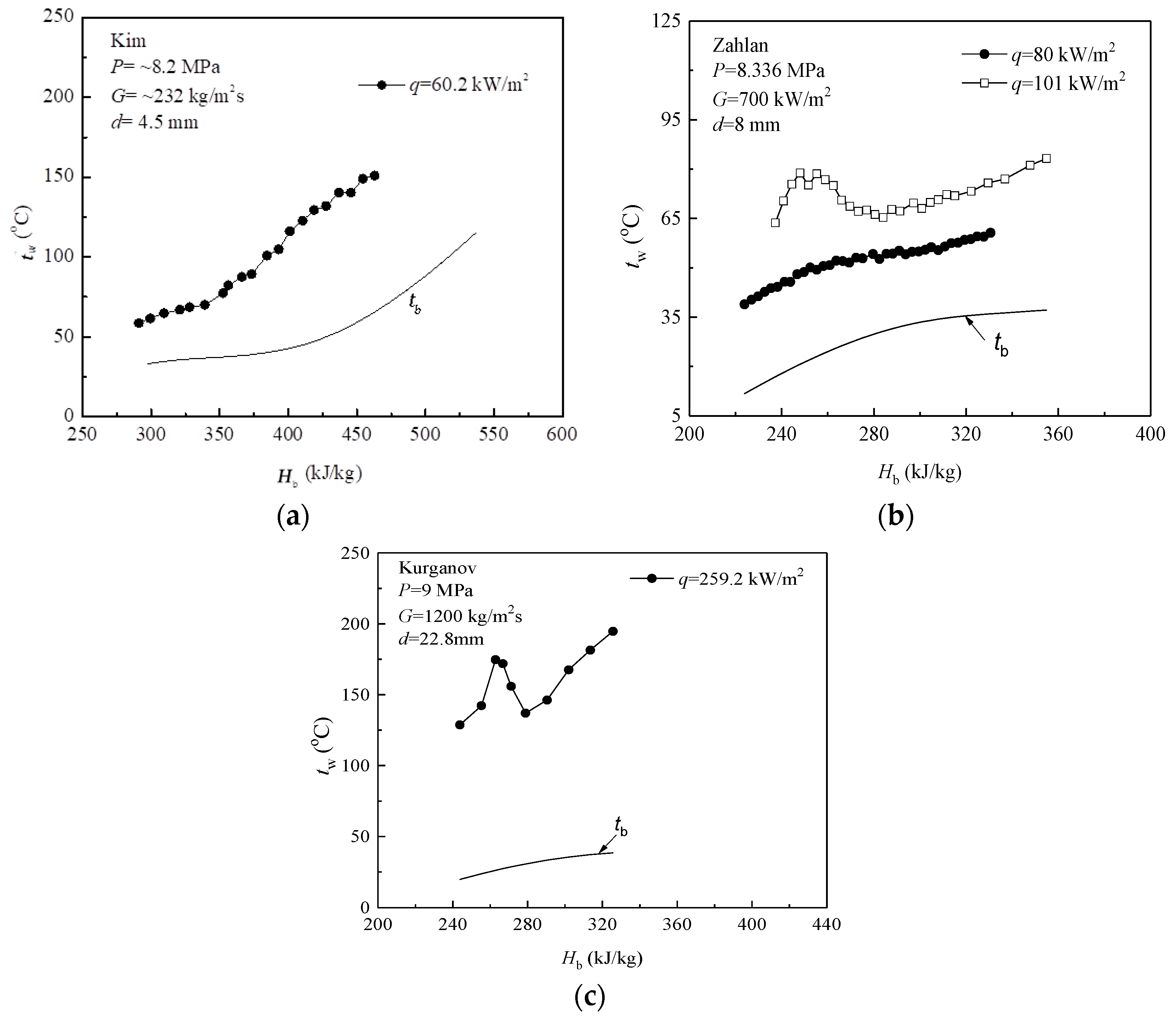
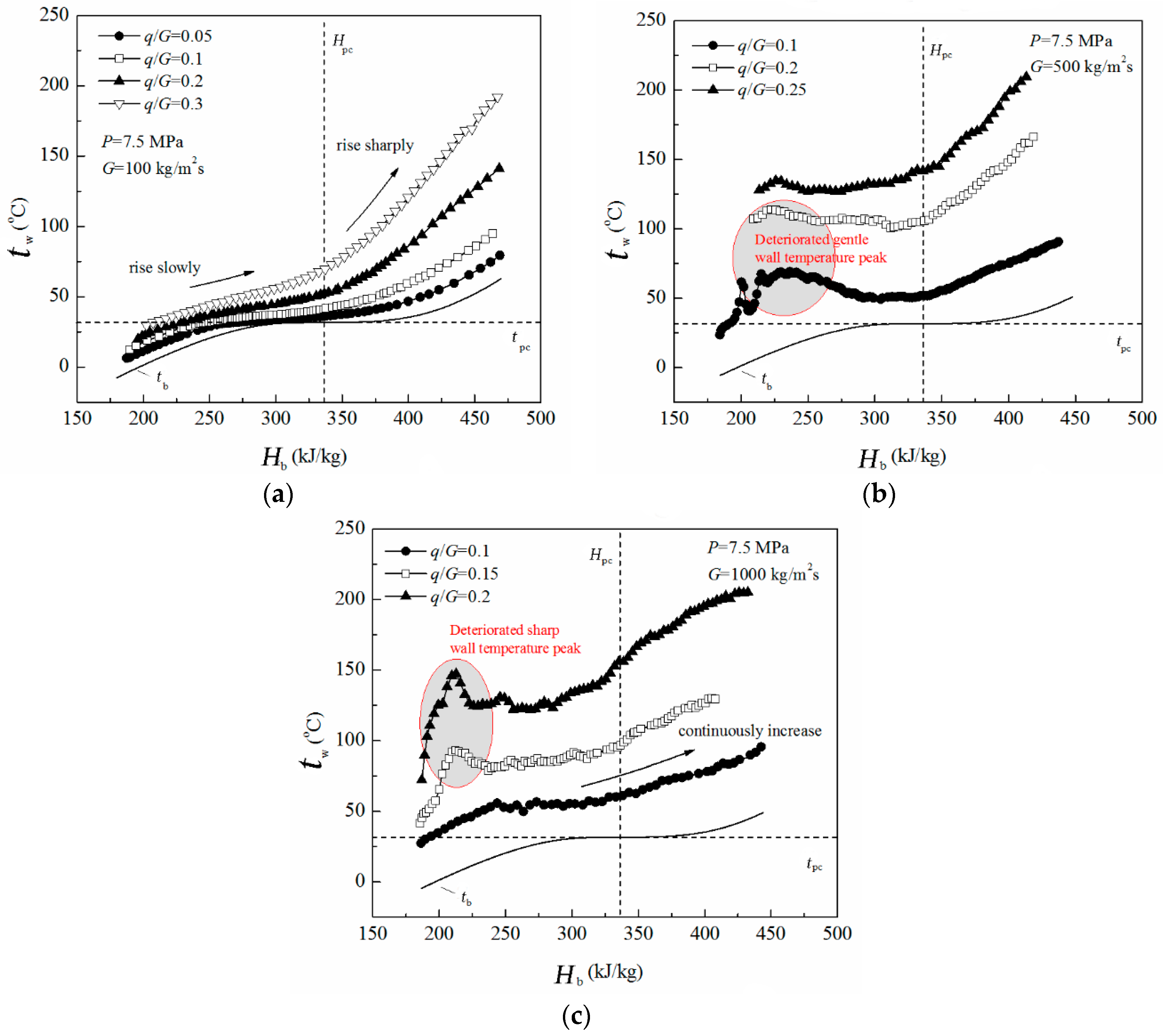






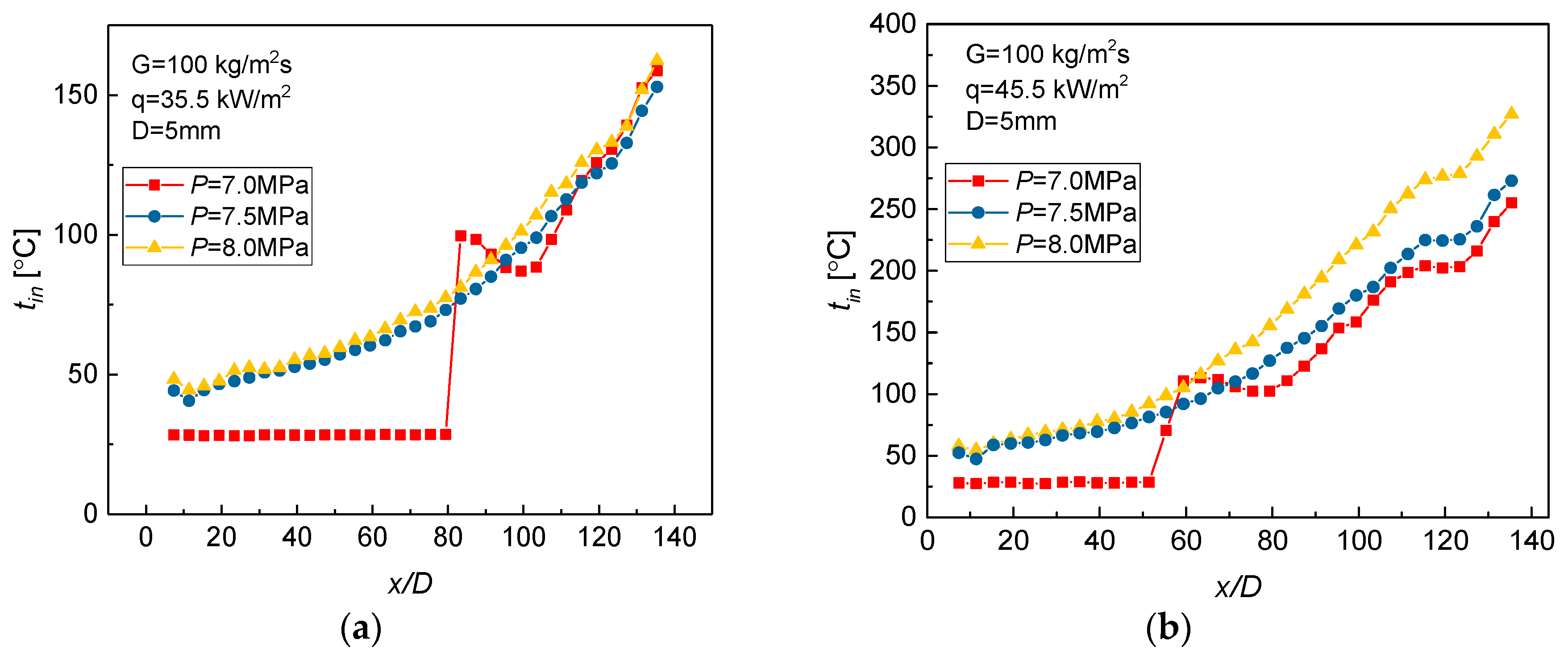
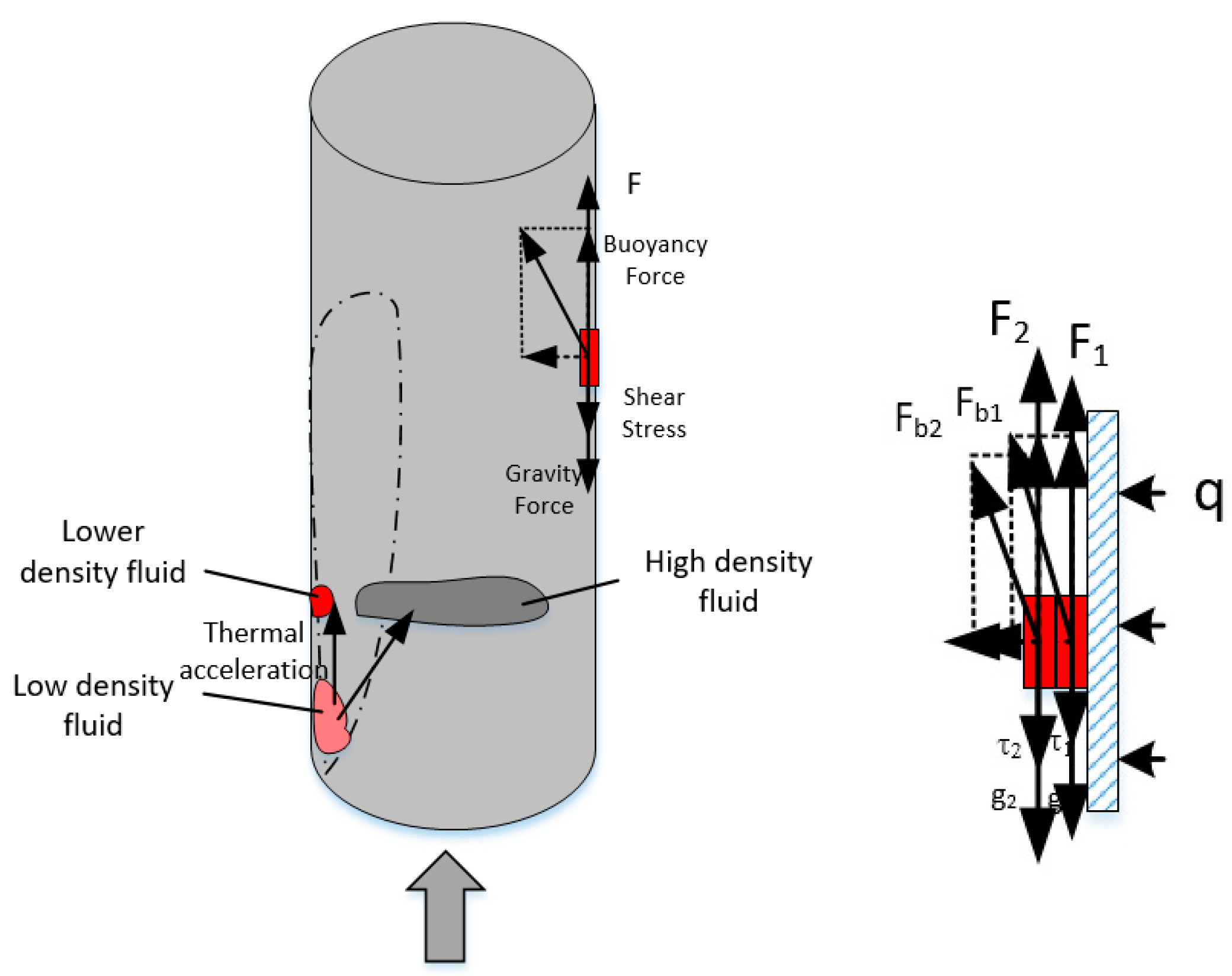
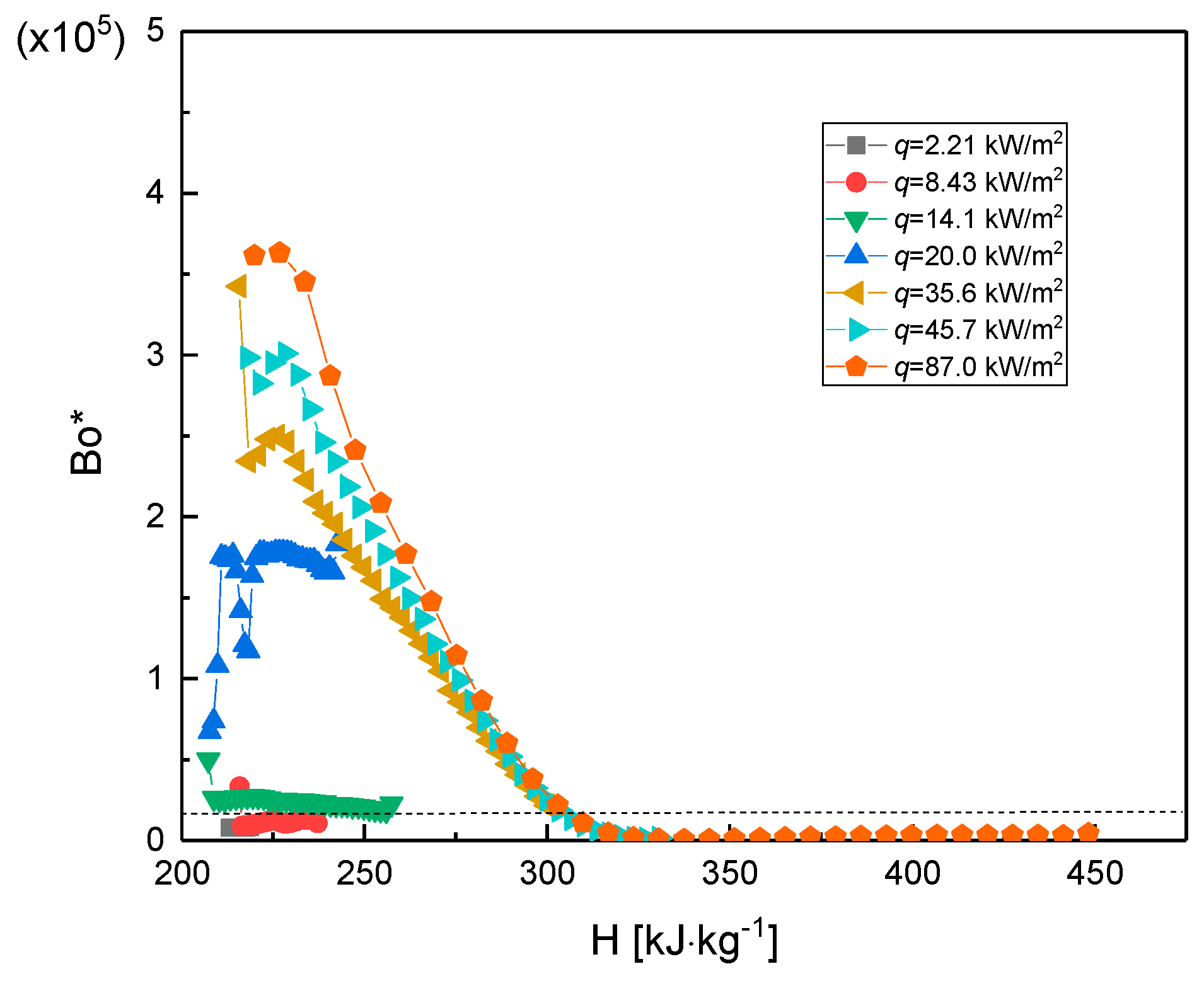
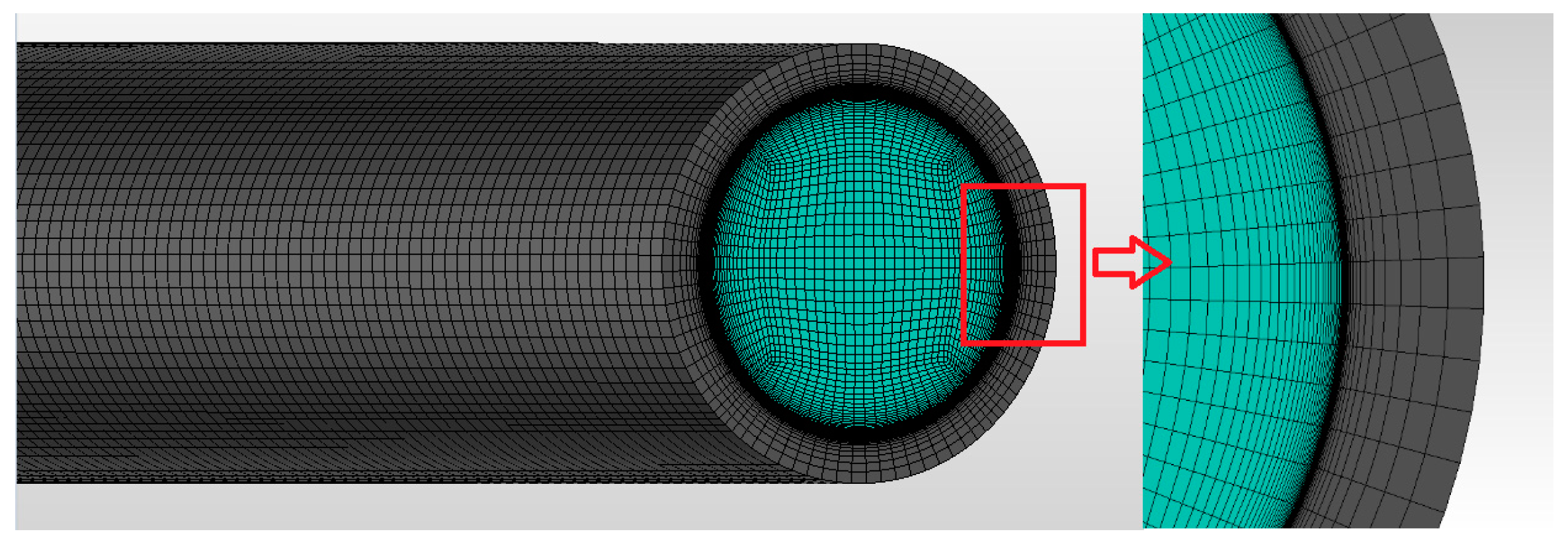

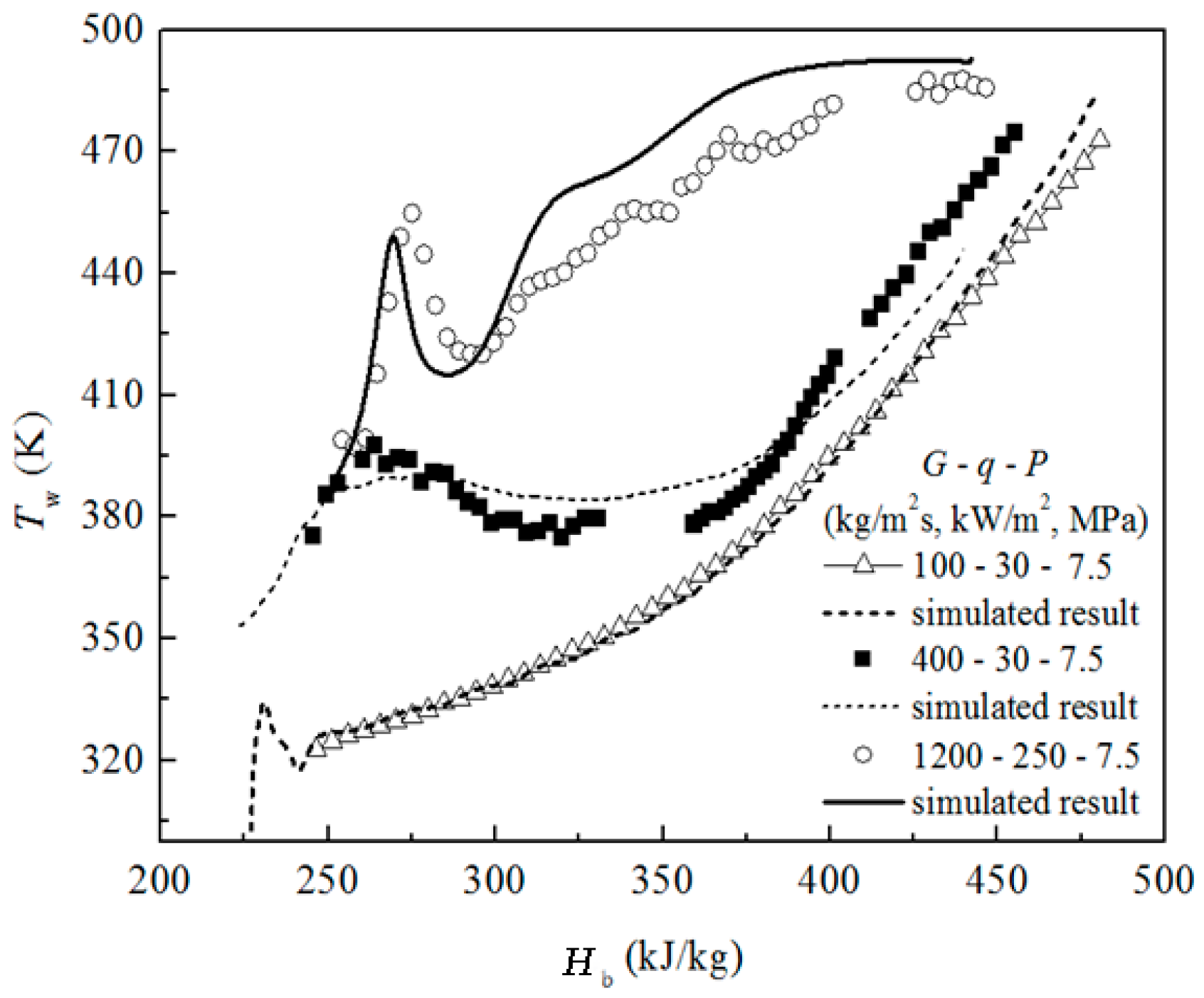
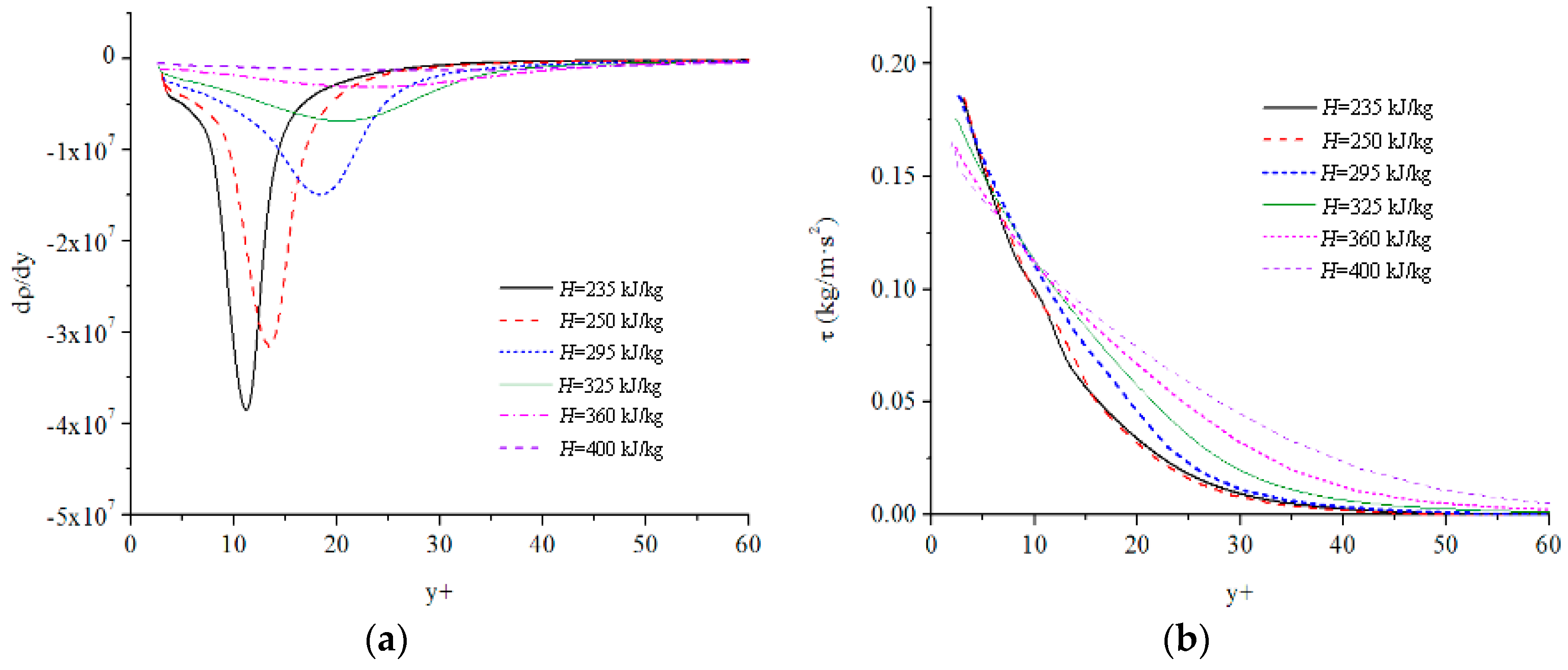
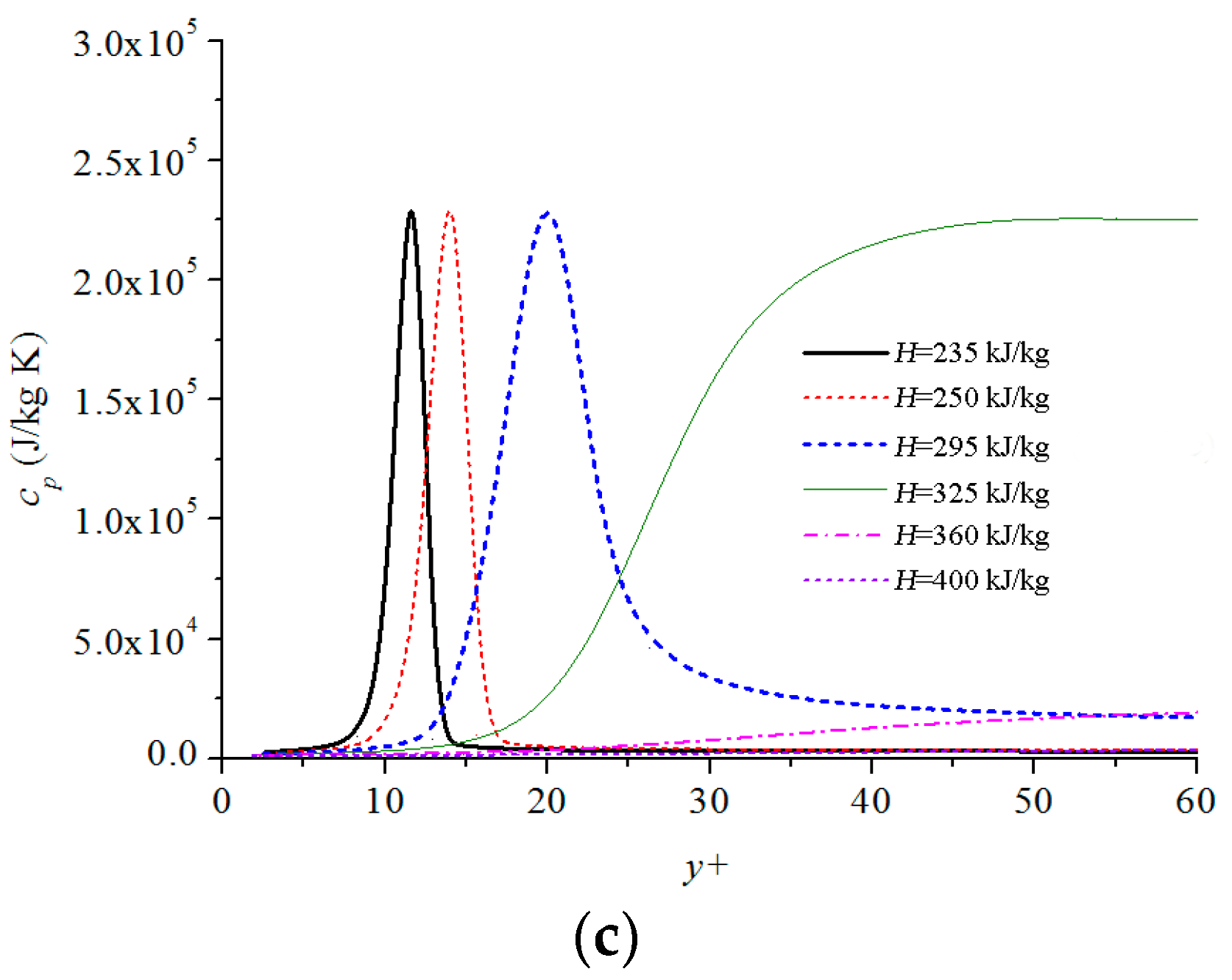
| Parameters | Value |
|---|---|
| Pressure (MPa) | 7.5 |
| Mass flux (kg/m2s) | 100, 400, 1200 |
| Heat flux (kW/m2) | 30, 120, 250 |
© 2017 by the authors. Licensee MDPI, Basel, Switzerland. This article is an open access article distributed under the terms and conditions of the Creative Commons Attribution (CC BY) license (http://creativecommons.org/licenses/by/4.0/).
Share and Cite
Lei, X.; Zhang, Q.; Zhang, J.; Li, H. Experimental and Numerical Investigation of Convective Heat Transfer of Supercritical Carbon Dioxide at Low Mass Fluxes. Appl. Sci. 2017, 7, 1260. https://doi.org/10.3390/app7121260
Lei X, Zhang Q, Zhang J, Li H. Experimental and Numerical Investigation of Convective Heat Transfer of Supercritical Carbon Dioxide at Low Mass Fluxes. Applied Sciences. 2017; 7(12):1260. https://doi.org/10.3390/app7121260
Chicago/Turabian StyleLei, Xianliang, Qian Zhang, Jun Zhang, and Huixiong Li. 2017. "Experimental and Numerical Investigation of Convective Heat Transfer of Supercritical Carbon Dioxide at Low Mass Fluxes" Applied Sciences 7, no. 12: 1260. https://doi.org/10.3390/app7121260



